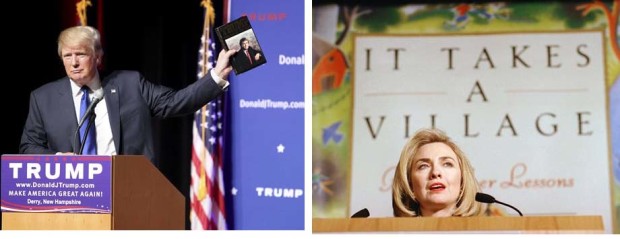NEW YORK — Donald J. Trump’s first book was a memoir/manifesto dedicated to a life of big-time negotiating. Hillary Clinton debuted with a call for community involvement in raising the young. Trump was a brash star in New York real estate who agreed to a six-figure contract for “Trump: The Art of the Deal.” For “It Takes a Village,” then-first lady Clinton accepted no advance and donated most of the royalties to charity.
Both books were best-sellers that attracted some controversy and helped lead to future releases. But from their opening sentences, “The Art of the Deal” and “It Takes a Village” signaled sharply contrasting styles and backgrounds for this year’s top presidential contenders.
“I don’t do it for the money,” Trump announced. “I’ve got enough, much more than I’ll ever need. I do it to do it. Deals are my art form.”
“Children are not rugged individualists,” Clinton declared. “They depend on the adults they know and on thousands more who make decisions every day that affect their well-being.”
Trump’s proliferating brand includes more than a dozen business and policy books, most recently last fall’s “Crippled America.” But the signature work of the Republican front-runner remains “The Art of the Deal,” which, ironically, wasn’t his idea. Published in 1987, “The Art of the Deal” was initiated by S.I. Newhouse of Conde Nast, which then owned Random House. Newhouse was anxious for a hit that could tap the readership of Lee Iacocca’s best-selling “Iacocca: An Autobiography” and believed Trump a strong candidate.
Trump agreed to a six-figure deal, according to “The Art of the Deal” editor Peter Osnos.
“Donald Trump … loved the idea of a book that would tell his story and make a big splash,” says Osnos, now editor at large for the Perseus Books Group imprint he founded, PublicAffairs.
Clinton thought of “It Takes a Village” soon after the 1994 midterm elections, when Republicans captured both the House of Representatives and the Senate and the first lady was blamed in part for her failed effort to overhaul the health care system.
In her million-selling memoir “Living History,” published in 2003, Clinton noted that the election was “helpful” to her because it sharpened her “focus on positive ways to respond to right-wing diatribes.”
She had written a Newsweek article critical of Republicans who wanted to place poor children in orphanages and she was ready to take on a more “ambitious” project.
For her publisher, Clinton chose Simon & Schuster. Her editor was Rebecca Saletan, who called the book a “labor of love” for the first lady, “something she worked really hard at.”
Both Clinton and Trump would face questions about their involvement in their books. After Trump said during a debate last fall that he “wrote ‘The Art of the Deal,'” co-author Tony Schwartz tweeted, “I wrote The Art of the Deal. Donald Trump read it.” Osnos believes the truth is somewhere in between, describing the editorial process as one for which the “gears ran smoothly.”
For “It Takes a Village,” the announced plan was for Georgetown University journalism professor Barbara Feinman to write the book, based on interviews with Clinton. But Feinman got angry when her name did not appear on the acknowledgements page — Clinton didn’t cite any individual, explaining that she feared omitting someone — leading to ongoing questions about the book’s authorship. Saletan recalls that numerous people assisted, with Clinton having the final say.
“I don’t at all remember it being planned to be an ‘as told to’ — and looking back on the process and Hillary’s deep involvement, I can’t imagine that that was anyone’s plan,” says Saletan, now vice president and editorial director of Riverhead Books.
Trump has mentioned “The Art of the Deal” countless times on the campaign trail and boasts that it is the best-selling business book of all time — a claim that’s been widely disputed. It did spend just under a year on The New York Times’ nonfiction best-seller list and helped establish him as a national celebrity. His presidential candidacy has revived interest in the book, which currently ranks in the top 200 on Amazon.com.
“It Takes a Village” spent several months on the Times’ list in 1996 even as conservatives such as Sen. Robert Dole of Kansas countered that “it takes a family” to raise a child and Clinton’s promotional tour was sidetracked by questions over her involvement in the Whitewater and White House travel office controversies (neither of which resulted in any charges against her).
In “Living History,” she remembered arriving for a planned speech at her alma mater, Wellesley College, and learning that Special Prosecutor Kenneth Starr had issued a subpoena for her to appear at a grand jury looking into the “Travelgate” scandal. Clinton testified in Washington the following week.
“I was out in the hallway during one of three breaks when a juror walked over and asked if I would sign his copy of ‘It Takes a Village,'” wrote Clinton, adding that she agreed to do so after her attorney, standing next to her, signaled his approval.
“I later learned that after an investigation into this ‘incident,’ the juror was dismissed from the panel.”
